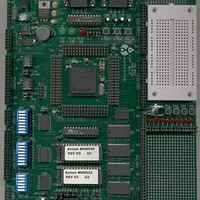MPC555CME Freescale Semiconductor, MPC555CME Datasheet - Page 707

MPC555CME
Manufacturer Part Number
MPC555CME
Description
KIT EVALUATION FOR MPC555
Manufacturer
Freescale Semiconductor
Type
Microcontrollerr
Datasheet
1.MPC555CME.pdf
(966 pages)
Specifications of MPC555CME
Contents
Module Board, Installation Guide, Power Supply, Cable, Software and more
Processor To Be Evaluated
MPC555
Data Bus Width
32 bit
Interface Type
RS-232
For Use With/related Products
MPC555
Lead Free Status / RoHS Status
Contains lead / RoHS non-compliant
- Current page: 707 of 966
- Download datasheet (13Mb)
21.3.1 Internal Watchpoints and Breakpoints
MPC555
USER’S MANUAL
This section describes the internal breakpoints and watchpoints support of the CPU.
For information on external breakpoints support refer to
Interface
Internal breakpoint and watchpoint support is based on eight comparators comparing
information on instruction and load/store cycles, two counters, and two AND-OR logic
structures. The comparators perform compare on the Instruction address (I-address),
on the load/store address (L-address) and on the load/store data (L-data).
The comparators are able to detect the following conditions: equal, not equal, greater
than, less than (greater than or equal and less than or equal are easily obtained from
these four conditions, for more information refer to
Types). Using the AND-OR logic structures “in range” and “out of range” detections
(on address and on data) are supported. Using the counters, it is possible to program
a breakpoint to be recognized after an event was detected a predefined number of
times.
The L-data comparators can operate on fix point data of load or store. When operating
on fix point data the L-data comparators are able to perform compare on bytes, half-
words and words and can treat numbers either as signed or as unsigned values.
The comparators generate match events. The match events enter the instruction
AND-OR logic where the instruction watchpoints and breakpoint are generated. The
instruction watchpoints, when asserted, may generate the instruction breakpoint. Two
of them may decrement one of the counters. If one of the instruction watchpoints ex-
pires in a counter that is counting, the instruction breakpoint is asserted.
The instruction watchpoints and the load/store match events (address and data) enter
the load/store AND-OR logic where the load/store watchpoints and breakpoint are
generated. The load/store watchpoints, when asserted, may generate the load/store
breakpoint or they may decrement one of the counters. When a counter that is count-
ing one of the load/store watchpoints expires, the load/store breakpoint is asserted.
Watchpoints progress in the machine and are reported on retirement. Internal break-
points progress in the machine until they reach the top of the history buffer when the
machine branches to the breakpoint exception routine.
In order to enable the user to use the breakpoint features without adding restrictions
on the software, the address of the load/store cycle that generated the load/store
breakpoint is not stored in the DAR (data address register), like other load/store type
exceptions. In case of a load/store breakpoint, the address of the load/store cycle that
generated the breakpoint is stored in an implementation-dependent register called the
BAR (breakpoint address register).
Key features of internal watchpoint and breakpoint support are:
• Four I-address comparators (each supports equal, not equal, greater than, less
• Two L-address comparators (each supports equal, not equal, greater than, less
/
than)
MPC556
DEVELOPMENT SUPPORT
Rev. 15 October 2000
21.3.1.6 Generating Six Compare
21.4 Development System
MOTOROLA
21-11
Related parts for MPC555CME
Image
Part Number
Description
Manufacturer
Datasheet
Request
R

Part Number:
Description:
MPC555 Interrupts
Manufacturer:
Freescale Semiconductor / Motorola
Datasheet:
Part Number:
Description:
Manufacturer:
Freescale Semiconductor, Inc
Datasheet:
Part Number:
Description:
Manufacturer:
Freescale Semiconductor, Inc
Datasheet:
Part Number:
Description:
Manufacturer:
Freescale Semiconductor, Inc
Datasheet:
Part Number:
Description:
Manufacturer:
Freescale Semiconductor, Inc
Datasheet:
Part Number:
Description:
Manufacturer:
Freescale Semiconductor, Inc
Datasheet:
Part Number:
Description:
Manufacturer:
Freescale Semiconductor, Inc
Datasheet:
Part Number:
Description:
Manufacturer:
Freescale Semiconductor, Inc
Datasheet:
Part Number:
Description:
Manufacturer:
Freescale Semiconductor, Inc
Datasheet:
Part Number:
Description:
Manufacturer:
Freescale Semiconductor, Inc
Datasheet:
Part Number:
Description:
Manufacturer:
Freescale Semiconductor, Inc
Datasheet:
Part Number:
Description:
Manufacturer:
Freescale Semiconductor, Inc
Datasheet:
Part Number:
Description:
Manufacturer:
Freescale Semiconductor, Inc
Datasheet:
Part Number:
Description:
Manufacturer:
Freescale Semiconductor, Inc
Datasheet:
Part Number:
Description:
Manufacturer:
Freescale Semiconductor, Inc
Datasheet:










